6712 Hollywood Blvd. Los Angeles, CA 90028 | map |
The Egyptian Theatre pages: an overview | Hollywood Blvd. views 1922-1954 | Hollywood Blvd. 1955-present | forecourt | lobby - earlier views | lobby - recent views | auditorium - earlier views | auditorium - recent views | booth | backstage | structural + 2021 renderings | Egyptian 2 & 3 | along Las Palmas Ave. | along McCadden Place |
The new booth: It's totally new construction done by Netflix during their 2021-2023 renovations. With the removal of the balcony, the new booth could be lower than the one built by the American Cinematheque and it's now even lower than the original 1922 height. A new elevator was installed on the left side of the booth and, as with the 1922 and 1998 installations, there's also access across the roof.
There's now a separate sound and broadcast control room located directly below the projection booth. Rebuild work on the Norelco projectors prior to the 2023 reinstallation was done by Chas Phillips of Phillips Optimal Presentations. Chas also worked on other aspects of the installation. The projection and sound installation was supervised by Dan Beedy of the firm DBPC.
Scroll
down lower on the page for a booth timeline and views of four of the
Egyptian's previous projection booth installations: 1922, 1968 D-150
downstairs, the 1998 Cinematheque installation and the 2016 nitrate
rebuild. Sorry,
no views (yet) of the 1926 "Don Juan" Vitaphone installation, the sound
equipment that was installed in 1928 or the 1955 TODD-AO "Oklahoma!"
installation.
The view down into "the pit" from in front of the elevator. Photo: Bill Counter - November 2023
Film projectors: The two Norelco AAIIs that had been installed by the American Cinematheque are back in the new booth. The Norelcos (#2236 and #2237) were originally installed in 1965 at the Lakeside Theatre in Metarie, near New Orleans. The machines have variable frequency drive as well as interlock capability for two-machine 3-D. The bases are now motorized for easier alignment when changing formats.
Lamphouses: The Christie SLH lamphouses that had been in use by the Cinematheque were reinstalled in the new booth, as seen in the photo above. By 2024 there was concern that heat from the lamps was embossing film and there were issues with flaking of the coating on the reflectors. In early 2025 the Christies were replaced with a pair of Kinoton lamps that can use bulbs up to 7K.
Former head operator Paul Rayton has commented: "We had Kinotons in there from the git-go [1998], and they were not up to the task. That was how the Christies got in there! The Kinotons sat in the storage room for a few years and then ended up being used out at the Aero."
Nitrate: The booth is nitrate capable with a rolling fire curtain on the front wall. Going to nitrate requires removal of the DTS and Dolby Digital heads atop the Norelcos and installation of the magazine cans and appropriate firetrap rollers.
Digital: Two new Barco units. One lives at the center port. The other gets parked to the left of Norelco #1 when not in use.
Sound upgrades: The theatre now has an Atmos installation. Alex Harbaugh designed the new sound system, including a separate house PA system. Alex worked with Dolby on the design of the Atmos installation.
2025 sound upgrades: Beginning with the November 2023 reopening there had been complaints about dialog intelligibility and the noticeable liveness of the room. Older films usually sound fine. New ones with more bass on the track sometimes suffer. It turns out that the reverb time was 3 seconds. In early 2025 plans were afoot to add more absorptive surfaces, a project with a reported budget of around $4 million that possibly would involve a summer shutdown of a few weeks. It's unknown whether the revamp would include sliding panels, curtains along the side walls or other measures.
Film sound: Academy optical, Dolby A and SR, Dolby Digital, DTS, 4 and 6 channel mag. No SDDS this time around. The Kinoton retrofit optical heads are switchable between red and white LEDs. There's a Dolby MPU mag preamp unit and a Dolby 650 processor. There are three Dolby Model 363 units, each with two Cat 300 SR/A modules, for six channels of noise reduction. Backstage there are five full-range stage channels plus subs.
Throw: 92' with an angle of 4 degrees.
A view across the back of the pit. Up near the amp racks are Netflix engineer Evan Norbom and former Egyptian head operator Paul Rayton. On the far right is equipment installer Chas Phillips. Photo: Bill Counter - November 2023
Back to the right for another look into the pit but also with a peek at the area beyond the right truss. Photo: Bill Counter - June 2023
1922 - The booth was upstairs when the theatre opened. There was no balcony but it was flanked by private boxes. Access to both the boxes and the booth was across the roof. The theatre initially had two Powers projectors along with followspots and effects projectors.
1926 - Vitaphone equipment is installed for Warner Bros. sound-on-disc production of "Don Juan." The film started its run as a silent but finished with the Vitaphone version along with Vitaphone shorts. The equipment was also used for a second feature, "The Better Ole." See the Warner Hollywood booth
page for information about
early Western Electric installations. There are also shots of Vitaphone equipment on the Carthay Circle projection page and the page about Inglewood's Granada Theatre.
1955
- Norelco DP70 35/70mm projectors (#601 and #611) were installed, along with an Ampex 6
channel sound system for the 70mm TODD-AO run of "Oklahoma!" Sound was
not on the film for this first TODD-AO release but run in sync from one
of two 6 channel dubbers using 35mm film with a full magnetic coating. A
deeply curved screen was installed, 60 feet or so in width. See
Egyptian Theatre overview page for more about TODD-AO and 70mm roadshow runs at the Egyptian.
1968
- A new booth was built downstairs for the installation of the D-150
system. The projectors were moved downstairs. Lamps were Ashcraft Super
Cinex. Sound was a new solid state Ampex "8 channel" system. It was the standard 6
channel configuration when used for 70mm but with the surrounds driven
by three amplifiers instead of one. A even bigger deeply curved screen
(75' measured along the curve) was installed.
1992 - The theatre closes.
1998
- The theatre reopens after the American Cinematheque remodel. The
booth was back upstairs but at a higher level than it was in 1922. They
installed two Norelco AAII 35/70mm projectors, a later version of the
1955 machines originally known as the DP70. This set (#2236 and #2237) came from the Lakeside Theatre
in Metairie, a suburb of New Orleans. Lamphouses were Christie Xenon with 6 Kw lamps. There was also a 16/35
Kinoton projector, later removed to allow space for a digital machine.
The theatre was equipped to reproduce all standard sound formats
including Dolby Digital, SDDS and DTS.
The Spielberg Theatre: This 78 seat house was dug down into what had been the rear of the house right seating area by the Cinematheque as part of their 1997-1998 renovations The throw was 35' with a 10' x 24' screen. The house was set up to run 35mm, 16mm and digital formats. Booth access was via a doorway in the inner lobby, opposite the ladies room. This theatre was filled in during the Netflix renovations. Former Egyptian head operator Paul Rayton has the story about the equipment:
"The plan, I think, was to have a pair of Kinoton FP-38ES in there, 35/16 convertible. We got one FP-38ES upstairs in the main booth, but the other two machines were never delivered, part of the fallout over the cost overruns and the ensuing payment disputes that then soured the relationship between American Cinematheque and Boston Light & Sound. I was questioned in the countervailing lawsuits between the two entities -- suits which ultimately ended in nothing for anyone ... including the non-delivery of expected equipment for finishing the Spielberg. So, the Spielberg had a single Cinemeccanica V-5 which I personally purchased, along with an Eprad double MUT, to be the vertical equivalent of a platter. And the 16mm projector was an Eastman 30. Both the Cinemeccanica and the Eastman were put into storage at the time of the Netflix takeover."
2016 - The upstairs booth was stripped to the walls for a retrofit to make it able to safely run nitrate prints. A new Barco DP4K-30L digital laser projector was acquired.
2020 - The theatre closes due to Covid restrictions. American Cinematheque later sells the building to Netflix.
2021 - The Cinematheque era booth was totally removed during the Netflix renovations. Also removed were the walls and floor of the area below that 1990s booth that still remained from the original 1922 booth. The lower part of the new two-level Netflix booth is in the space originally used in 1922 but down a bit lower.
2023 - The theatre reopened in November with an invitational screening of "Singin' in the Rain," two public showings of David Fincher's "The Killing" and then a twelve-day 70mm festival.
The Egyptian's booth in 1922. It's a photo that appeared in the November 11, 1922 issue of Moving Picture World with the caption: "Projection Room, Grauman's Egyptian. Showing the decorated walls, the two Power's projectors, with vent flues, also the Power's Stereopticon." Thanks to Jean Hunter for the find. She added the item as a comment to a "Don Juan" premiere photo posted by Richard Adkins on the Hollywood Heritage Facebook page.
When the photo was used with "The Egyptian's New Look," an article in the January 21, 1969 issue of the Independent Film Journal about the D-150 renovations they noted that the operator on the left was Roy Benson. Earl Hamilton, who was the head operator at Grauman's Metropolitan when it opened in 1923, is on the right.
The only access to the booth was across the roof, accessed via the stairs at the house left end of the lobby that went up to the men's smoking room on the second floor. A few more stairs got you to a door onto the roof above the lobby. After a walk across the roof above the rear of the auditorium one could enter a film vault behind the booth. You'd get to the booth by entering another door to the west of the vault. A corridor passed a toilet room, a storage room, and then, after taking six steps down, from you'd be at the back of the booth. Also on the roof were doors house left and house right to get you into the private boxes (aka "balconies") on either side of the booth. A ladder on the east wall of the booth allowed access to the higher level of the roof, the organ chambers, and upper part of the stagehouse.
In "Egyptian in Both Architecture and Decoration is Grauman's New House," a separate article in the same issue of Moving Picture World, it was mentioned that the theatre's "harmony of carving and coloring has been extended even to the projection room." More details:
"Mechanics and art join hands to make a perfect screen display of motion pictures and that is why Sid Grauman pays so much detailed attention to the projection rooms to his theatres. Grauman long ago realized that good pictures, if poorly projected, will not be a popular success and this understanding of the screen art is responsible for the minute care with which the projection rooms of Grauman's theatres are equipped.
"Remote Control System - This equipment is operated by the projectionist by means of automatic electrical controls arranged in three stations, from any one of which he will have complete control of the entire equipment. The comfort of the projection room has been further enhanced by placing the rheostats of the filming machines in a specially made cabinet. Like the main room, this is ventilated by a fresh air system that insures a constant circulation of ozone. Because the rheostats generate an intense heat, the customary plan of installing them in the projection room was abandoned and in the Egyptian a separate compartment provided and in this also has been placed the Enterprise automatic re-wind on which the films will be coiled up after they have been run in the projection room.
This article appeared in the November 18, 1922 issue of Exhibitors Herald. It's on Internet Archive.
The photo comes from a January 29, 1969 article in the Motion Picture Herald. It appears on the Egyptian Theatre page of Roland Lataille's comprehensive InCinerama.com website, which has the complete article about the D-150 remodeling. The photo also appeared as the cover of the Modern Theatre section of the January 13, 1969 issue of Boxoffice. See their article "A $250,000 Renovation in Six Weeks..." from the same issue. It was also with "The Egyptian's New Look," an article in the January 21, 1969 issue of the Independent Film Journal.
A view of the D-150 masking control panel from the Bill Gabel collection.
The main floor booth and the D-150 screen were removed during the 1997-1998 American Cinematheque renovations. The projectors ended up with Boston Light and Sound.
During the American Cinematheque renovations the booth was moved back upstairs, but positioned at a higher level than it was in 1922. This was necessitated by the addition of a balcony to the theatre.
There were 2 Norelco AAII machines of 1965 vintage (#2236 and #2237) with variable frequency drives. Sound capability included Mono optical, Dolby A and SR, Dolby digital, Sony SDDS, DTS and mag for 70. Originally there was a Kinoton 16/35mm machine but that was replaced by a digital projector. At the end of this booth's time it was a Barco laser projector. Boston Light and Sound did the installation.
The throw was 92' at about a 10 degree angle. The Cinematheque's screen was 27' x 53'. See the backstage page for some information on screen installations over the years at the theatre.
The two Norelco AAII 35/70mm projectors in the Egyptian's booth before the renovations to make the installation nitrate-friendly. That red glow on the top of machine #1 is the LED on the Dolby Digital soundhead. Photo: Bill Counter - 2014
A door open view. Photo: Wayne Nabeta on Flickr - 2008. Thanks, Wayne! See the rest of his Egyptian Theatre set for more booth views as well as fine shots of the rest of the building.
A look at the digital soundheads mounted atop the machine. Photo: Wayne Nabeta on Flickr - 2008
Machine #2 with the film trap open, ready to thread 35mm. It's a photo
by Leo Enticknap, one of eight of his 2014 photos of the equipment in
the Egyptian booth that appear with the Wikipedia article on the Norelco DP-70 projector.
The projector motor speed control cabinet, at the time on the front wall to the left of machine #1. The variable frequency drive allowed speeds from 16 to 30 fps. Or the two machines could be interlocked for dual machine 3-D. Photo: Leo Enticknap - Wikipedia - 2014
A look toward the rear of the booth during one of the tours the theatre offered. The sound racks are in the distance on the left side of the photo. Thanks to Wayne Nabeta on Flickr for his 2008 photos.
In the summer of 2016 the booth was stripped to the walls for a retrofit to make it able to safely run nitrate prints. The new booth design was by BAR Architects. It was a joint project of the theatre, the Film Foundation, and TCM. See more about the project in the Foundation's press release "Nitrate at the Egyptian." Thanks to the theatre for the photos -- this is one that appeared on the American Cinematheque Facebook page.
The bases of the Norelco AAIIs back in place in mid-August 2016. Following the renovation, the front wall of the booth was actually double. The surface we see here is new. Fire shutters were between this new wall and the original booth wall beyond. It's a photo from the Egyptian Theatre Facebook page.
Bolting the lamphouse brackets back on. It's a photo from the Egyptian Theatre Facebook page.
A look across the booth. Note the new wiring gutters on the front wall and other new electrical work. The photo was included in an August 18, 2016 post on the American Cinematheque Facebook page.
KTLA's Gayle Anderson getting a look at the work involved in the summer 2016 booth makeover. This photo and the two below appear in a 26 photo set "KTLA Morning News with Gayle Anderson Visits the Egyptian" that was on the Egyptian Facebook page in August 2016. In addition to the booth shots there are many views of forecourt restoration work as well as a discussion of roof repairs and lobby improvements.
Gayle Anderson talking to Paul Smith of D-Mation, the "integrator" who was supervising all the tech work in the booth during the renovation.
An electrician working behind the amp racks. Its a shot in the 26 photo set on the Egyptian Facebook page. July 2016 Stories on the retrofit included a Deadline article "...Retrofit for 'Rare' 35mm Nitrate Film Projection" and one on LAist: "Egyptian Theatre...To Screen Rare Nitrate Prints."
The booth was back in action in the fall of 2016. During the renovations, the theatre ran DCPs with a temporary Barco projector set up in the balcony.
It was a bit of work to get the Norelcos ready to run nitrate prints. Here veteran projectionists Paul Rayton and Mike Schleiger are putting a top magazine back on. Guide rollers at the top and bottom of the heads get replaced with fire trap rollers designed for nitrate film. It's a March 2018 photo from the Egyptian Theatre Facebook page. See the post for a total of eight photos.
Here the digital soundheads normally on top of the machines had been removed to allow a nitrate print to be run. Photo: Egyptian Theatre Facebook page
| Hollywood Theatres: overview and alphabetical lists | Hollywood Theatres: list by address | Hollywood Christmas | Downtown theatres | Westside | Westwood and Brentwood | Along the Coast | [more] Los Angeles movie palaces | L.A. Theatres: main alphabetical list | L.A. Theatres: list by address | theatre history resources | film and theatre tech resources | theatres in movies | LA Theatres on facebook | contact info | welcome and site navigation guide |











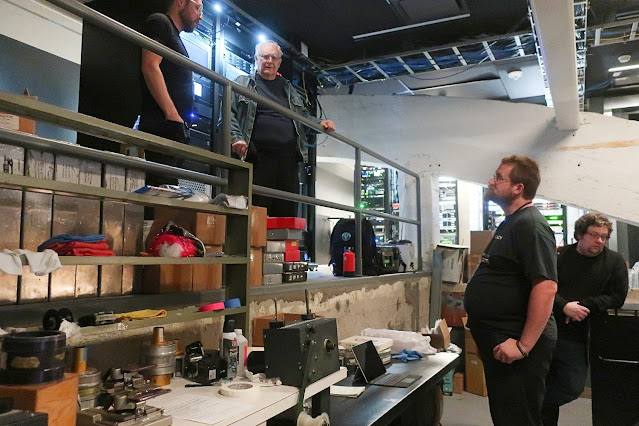

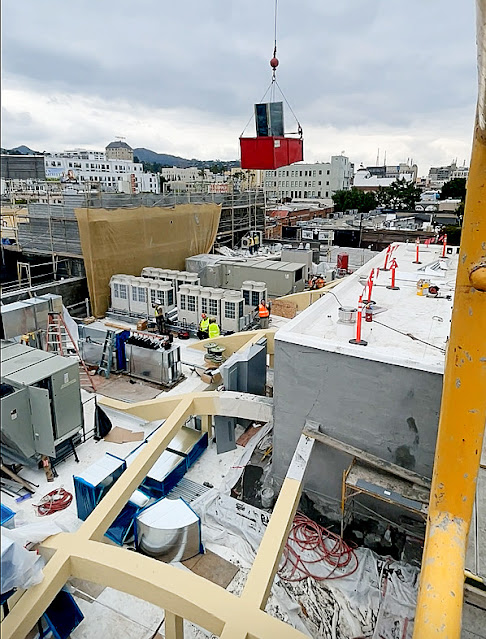


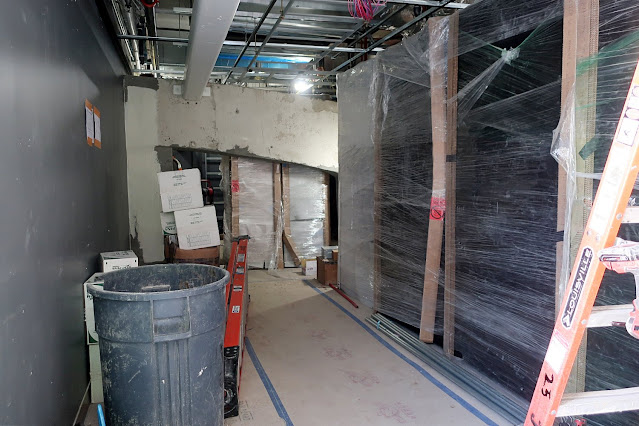




























































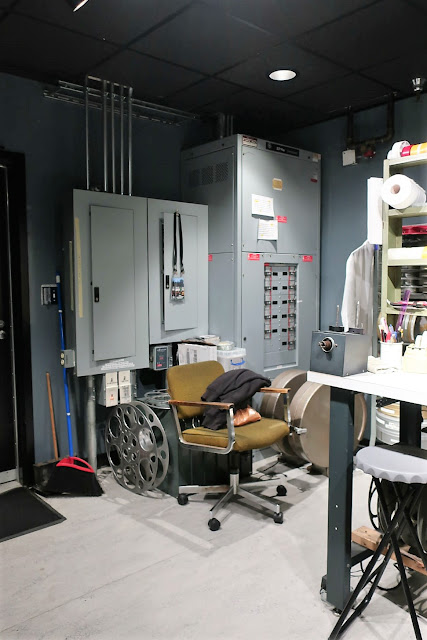







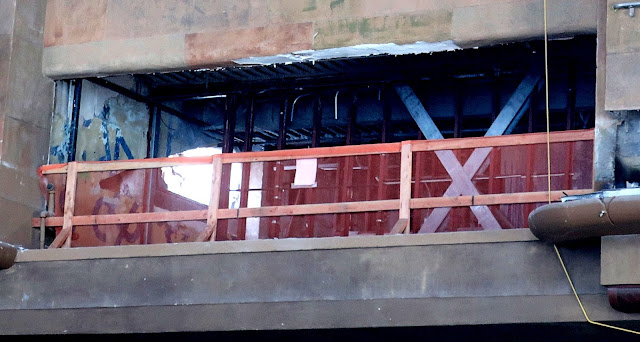






No comments:
Post a Comment